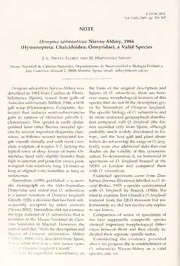
Ormyrus salmanticus Nieves-Aldrey, 1984 (Hymenoptera: Chalcidoidea: Ormyridae), a valid species PDF
Preview Ormyrus salmanticus Nieves-Aldrey, 1984 (Hymenoptera: Chalcidoidea: Ormyridae), a valid species
HYM. RES. J. Vol. 14(2), 2005, pp. 206-207 NOTE Ormyrns salmanticus Nieves-Aldrey, 1984 (Hymenoptera: Chalcidoidea: Ormyridae), a Valid Species L. Nieves-Aldrey and M. Hernandez Nieves J. Museo Nacional de Ciencias Naturales, Departamento de Biodiversidad y Biologfa Evolutiva, Jose Gutierrez Abascal 2, 28006 Madrid, Spain; email: [email protected] Ormyrus salmanticus Nieves-Aldrey was the basis of the original description and described in 1984 from Casillas de Flores, figures of O. salmanticus, there are how- Salamanca (Spain), reared from galls of ever many morphological features of this Aulacidea subterminalis Niblett, 1946, a herb species that do not fit the description giv- gall wasp (Hymenoptera, Cynipidae, Ay- en by Narendran of Ormyrus langlandi. lacini) that induces semi-subterranean The specific biology of O. salmanticus and galls in runners of Hieracium pilosella L. its more restricted geographical distribu- (Asteraceae). This species is easily distin- tion compared with O. langlandi (the for- guished from other Iberian ormyrid spe- mer recorded only from Spain, although cies by several important diagnostic char- probably much widely distributed in Eu- acters, as follows: second metasomal ter- rope, and the host gall and plant distri- gite smooth dorsally and with weak cren- bution do not overlap the range of O. lang- ulate sculpture of tergites 3-7, lacking the landi), were also additional data that cast typical rows of deep foveae of many Or- doubts on the validity of this synonymi- myridae; head only slightly broader than zation. To demonstrate it, weborrowed 16 high in anterior and posterior views; post- specimens of O. langlandi housed at the NHM marginal vein relatively long, 1.6 times as of London and compared them long as stigmal vein; metatibia as long as with O. salmanticus. metatarsus. Examined specimens came from Zim- Narendran (1999) published a system- babwe (former Rhodesia) labelled as O. de- atic monograph on the Indo-Australian caryi Risbec, 1955, a species synonymized Ormyridae and stated that O. salmanticus with O. langlandi by Boucek (1988). We is a junior synonym of Ormyrus langlandi tried to examine first Girault's O. langlandi Girault, 1920, a decision thathasbeensub- material from the QLD museum but un- sequently accepted by other authors fortunately we did not receive any replies (Noyes 2002). Narendran did not examine to our letters. the type material of O. salmanticus that is Comparison of series of specimens of available at the Museo Nacional de Cien- the two supposedly conspecific species cias Naturales in Madrid. However, the showed important morphological differ- author said that "from the descriptionand ences between them and thus clearly in- figures of Ormyrus salamanticus Aldrey dicated their separate specific status. (Aldrey, 1984) (sic), described from Spain, Considering the evidence provided is evident that it is a new junior syno- above we propose the re-establishment of i of Ormyrus langlandi Girault". O. salmanticus Nieves-Aldrey as a valid spite its superficial resemblance, on species, stat. res. Volume 14, Number 2, 2005 207 Table 1. Major morphological differencesbetween O. langlandi and O. salmanticus. Diagnosticcharacters O.salmanticus 1 male,3Femalesexamined O.langlandi6males, 10femalesexamined Female antenna Two anelli but the second anellus bears Two anelli; second anellus transverse, a single placodeal sensilla and is 1.3 about 2 times as wide as long; flagel- times as long as wide; flagellar seg- lar segments 2 to 5 clearly longer ments 2 to 5 clearly transverse, about than wide, about 1.3 times as long as 1.4 times as wide as long. Placodeal wide. Placodeal sensillae of flagellar sensillae of flagellar segments ar- segments arranged in two rows. ranged in a single row. Male antenna Flagellar segments transverse. Placo- Flagellar segments longer than wide. deal sensillae arranged in a single Placodeal sensillae smaller, arranged row. in four or five rows. Forewing Postmarginal vein relatively longer; Postmarginal vein relatively much marginal vein 1.2 times as long as shorter; marginal vein 3.5 times as postmarginal; postmarginal vein 3.2 long as postmarginal; postmarginal times as long as stigmal vein. vein 1.6 times as long as stigmal vein. Metasoma Sculpture on dorsal part of second me- Dorsal part ofsecond metasomal ter- tasomal tergite of female absent; ter- gite of female with strong reticulate gite completely smooth. sculpture. Biology and distribution A parasitoid ofAulacidea subterminalis Biology unknown. Recorded from Aus- Niblett that inducesgalls in runners tralia, India, Laos, China, Zimbabwe ofHieracium pilosella L. Recorded and Madagascar. only from Salamanca and Zaragoza (Spain) but probably much more widely distributed following its host gall wasp and plant. LITERATURE CITED Narendran, Department of Zoology, University ofCalicut, Kerala, India. iii+227pp. Boucek, Z. 1988. Australasian Chalcidoidea (Hyme- Nieves-Aldrey, J. L. 1984. Primeros datos sobre los noptera). A biosystematic revision of genera of representantes de la familia Ormyridae en 1 ^~ fourteen families, with a reclassification ofspecies. pana, con description de una nueva especie CAB International, Wallingford, Oxon, U.K. (Hym., Chalcidoidea). Graellsia 40: 119-127. 832pp. Noyes, J. S. 2002.—Interactive Catalogue of World Chal- Narendran,T.C. 1999.Indo-Australian Ormyridae(Hy- cidoidea (2001 secondedition). CD-Rom. Taxapad menoptera: Chalcidoidea). Privately published,T.C. and The Natural History Museum, London.
